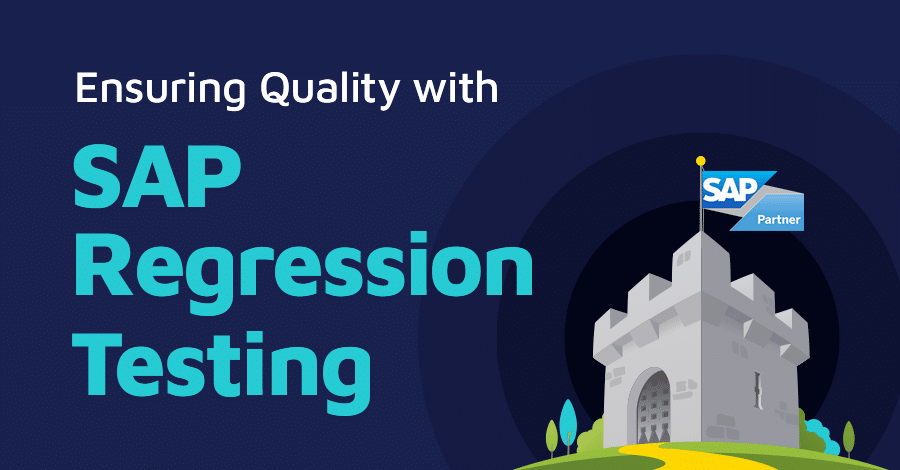Table of Content
When it comes to SAP systems, a single glitch can ripple across critical business processes, causing disruptions, delays, and unexpected costs.
It’s a challenge keeping up with all the customizations, managing a mountain of test cases, and ensuring data consistency. With S/4HANA and those frequent updates, you need to be on your toes to catch any sneaky bugs.
What is SAP Regression Testing?
SAP regression testing is the process of re-testing existing functionalities after making changes to your SAP environment, whether it’s a system update, introducing new business processes, configuration adjustments, or code modification. The goal? To ensure that nothing breaks. In other words, regression testing acts as a safety net that verifies your updates haven’t disrupted your business-critical operations.
Imagine updating a piece of your SAP system and suddenly your finance team can’t process invoices, or your supply chain grinds to a halt. That’s the nightmare scenario regression testing is designed to avoid.
Let’s break down what SAP regression testing entails, why it’s essential, and how to optimize it to drive continuous business operation.
Why SAP Regression Testing Matters
Safeguard Business Continuity
Your SAP system is the backbone of your business. When one part fails, the impact isn’t isolated. Finance, HR, Logistics, and Customer Support can all feel the effects. Regression testing ensures these interconnected processes remain intact.
Maintain Compliance
Whether it’s GDPR, SOX, or industry-specific regulations, compliance requirements demand consistent, error-free operations. Regression testing helps prove due diligence, avoiding compliance penalties.
Improve Change Confidence
Frequent updates are a reality for SAP systems, especially with S/4HANA’s cloud-first approach. Regression testing gives your team the confidence to roll out updates without fearing business disruptions.
Enhance User Experience
End-users rely on SAP to perform their jobs. A buggy system isn’t just frustrating; it’s costly. Regular regression testing ensures a seamless user experience, which boosts productivity and satisfaction.
Common Challenges in SAP Regression Testing
While regression testing is essential, it’s not without its complexities. Here are the most common pain points businesses face:
High Resource Demands:
SAP environments are complex, and manual testing can drain resources quickly.
Lengthy Testing Cycles:
Traditional approaches often lead to long test cycles, delaying deployments.
Coverage Gaps:
With interconnected processes, missing a critical test scenario can spell disaster.
Lack of Automation:
Relying solely on manual testing introduces human error and inefficiencies.
How to Optimize SAP Regression Testing
Prioritize Test Automation
Manual testing has its place, but it’s not enough for regression testing. Automated testing tools streamline the process, reduce human error, and improve coverage. Consider leveraging tools like Panaya’s AI-driven code-less Test Automation to automate and accelerate your testing.
Focus on Risk-Based Testing
Not all changes carry the same level of risk. By prioritizing high-impact areas, you can allocate resources more effectively. Identify which business processes are most critical and test them rigorously.
Maintain a Living Test Repository
Your SAP system evolves, and so should your test cases. A dynamic repository ensures your test suite stays relevant and comprehensive.
Leverage AI and GenAI
- Get real-time assistance with script writing and complex operations like custom code or locators.
- Pinpoint potential risk areas and optimize test coverage with AI-driven insights.
- Create Tests by describing scenarios in natural language.
- Maintain resilient and up-to-date tests with AI-driven self healing locators that adjust according to UI changes.
At Panaya, we leverage our extensive AI expertise to guide you on what to test, what to automate and how.

Real-Life Impact of Effective Regression Testing
Let’s look at an example. A global manufacturing company was migrating to SAP S/4HANA and introduced manual regression testing into their change management process. By automating 80% of their test cases, they cut testing cycles by 50% and reduced post-deployment issues by 70%. Not only did this save time and money, but it also gave the business confidence to innovate without fear of disruptions.
Key Takeaways
- SAP regression testing is crucial for maintaining stability, compliance, and a seamless user experience.
- Automation and risk-based testing are game-changers for efficiency and coverage.
- Collaboration across IT and business teams ensures comprehensive validation of end-to-end processes.
- AI and GenAI can pinpoint risks and improve test accuracy, helping businesses stay proactive.
Final Thoughts
- Regression testing is the unsung hero of ERP quality assurance. It protects your operations, maintains compliance, and enables smooth, continuous improvement. However, to get the most out of it, businesses must move beyond manual, ad-hoc testing and embrace automation, collaboration, and AI/GenAI.
- If you’re ready to elevate your regression testing strategy, consider partnering with Panaya. Our solutions simplify and accelerate testing, so you can deliver quality at the speed of change.
- Don’t wait for a disruption to expose weaknesses in your SAP system. Be proactive, stay agile, and keep quality at the heart of your operations.
